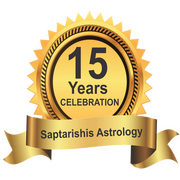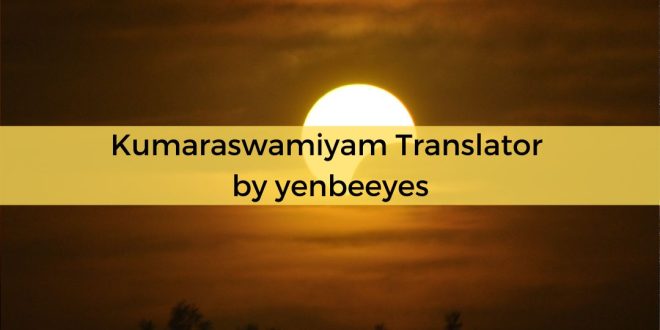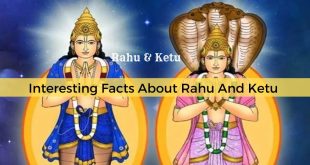Related Articles
It is customary for most of the Hindus to put the above symbol before start of any auspicious writings such as Marriage Invitation, engagement, starting a new business etc. etc. Some of us when we take a paper and pen to start writing something, we invariably start with the above symbol which is called ‘Pillayar Suzhi’ in Tamil if translated into the foreign language will mean that ‘Pillayar’ (indicates Lord Ganesha) and ‘Suzhi’ literally means a circle and the inner meaning is fate. We by this symbol invoke the blessings of Lord Ganesha (figuratively) that the fate of the proposed writing on that piece of paper should be a favourable one. So instead of writing a prayer shloka as has been done in all the astrological treatises, I by putting the above symbol silently pray to Lord Ganesha, that this venture of mine should become a success.
Readers have already read four parts of the great Tamil Work Kumaraswamiyam published through the pages of Sapatarishis Astrology. I have been entrusted with the task of completing the rest. Kumaraswamiyam is one of the toughest Tamil language Jyotish work and many of the words used therein do not find a place in Tamil dictionary itself. Unless, one is very well versed in Tamil language that too the ancient poetical scripts, it is next to impossible to decipher what is stated by the author. I do not consider myself competent enough to interpret the difficult verses as I am not a scholar in Tamil. Yet with the grace of God and the blessings of my Guru, I have natured upon this translation. There are bound to be mistakes/errors in my translation, due to lack of knowledge or wrong understanding of the verses, for which I squarely take the blame on myself. Readers who are well versed in Tamil language, if they come across any wrong interpretation that may be brought to the notice of myself through Saptarishi Astrology so that proper corrections may be issued. On no account I do not want the readers to be misguided by my interpretations and thereby do not wish to create and accumulate a bad Karma. Thanks for the patient reading and now on to the verses.
குமாரசுவாமீயம்-5 ஆம் பகுதி
Kumaraswamiyam-5th Part
There are very many Tamil editions of the book where the shloka numbers differ. Hence I will not give any numbers for the verses.
நட்சத்திர தாத்கால ஜீவாஜீவன், சூலம், மகாசூலம், சலாவேதை பாலுள்ள
நட்சத்திரம், மலடு அல்லது வயிரமுள்ள நட்சத்திரம்
Nakshatras with Temporary life, Trident, Great Trident, Afflictions,
Milky and impotent or hard.
தபனனுற நாட்கிடமொன் றேழேக நான்காய்ச்
சாவதரை சாதலுயிர் சாற்றுவர்மற் றவைக்கும்
சுபர்விதுநேர் நாட்சூலம் பவர்க்குமா சூற்பேர்
சுசிமுதனா லேழ்வரைநான் முகத்திடமேற் றொடிலாம்
உபயவரை கோணுறமற் றைவரைமுற் போல
உறிலதுச லாவேதை இவர்களுறி லுருட்டில்
உபயமுத னாழிமுதன் மூன்றுதைநே ராறு
மொழிவதிப்பா லப்பாற்பன் மூன்றுமற்றவா குவதே.
Nakshatras are classified into four main types through this verse.
The first type of Nakshatra is the life as well as death. For this the author takes the Nakshatra in which Sun is placed. [Probably because Sun is the giver of life and light]. The previous as well as the subsequent Nakshatras from the one in which Sun is placed are termed as ‘Death’ or ‘Destructive Nakshatras. The Tamil word used is ‘Maaranam’ which is normally used to denote killing using witchcraft or magic or enchantment. Then go back by seven Nakshatras and go forward by seven Nakshatras and these 14 Nakshatras are termed as ‘Artha Pranan’ in Tamil meaning Half life or little destructible. By now we would have covered 8 Nakshatras above and below the Nakshatra where Sun stands. Then take one Nakshatra above and one Nakshatra below from where you left and these two would be termed as ‘Death’. The remaining four Nakshatras prior to this and after this are termed as Full life. An example will clarify this.
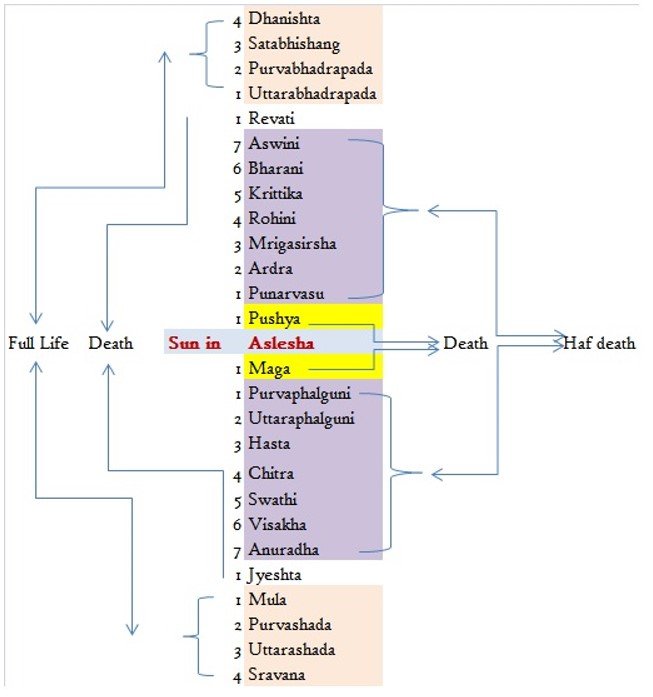
The second type of classification of nakshatras is termed as Trident and Great Trident. Draw 7 horizontal lines and draw seven vertical lines cutting across the horizontal lines. Now we get 28 points taking all four sides of the lines so drawn. In this all the 28 Nakshatras are placed beginning from Krittika starting at the left hand top corner and going clockwise. Here Abhjit nakshatra is also to be included. Just as a trident has 3 pointed figures, here three points are chosen. Find out the Nakshatra in which Moon is placed. Locate the position of this nakshatra in the figure drawn above and go to the opposite point. In the Nakshatra found in the opposite side, if a benefic planet is placed then it is Trident nakshatra and if a malefic planet is placed then it is a Great Trident Nakshatra. See figure below: (For want of space only first three letters of the Nakshatra are given in the figure).
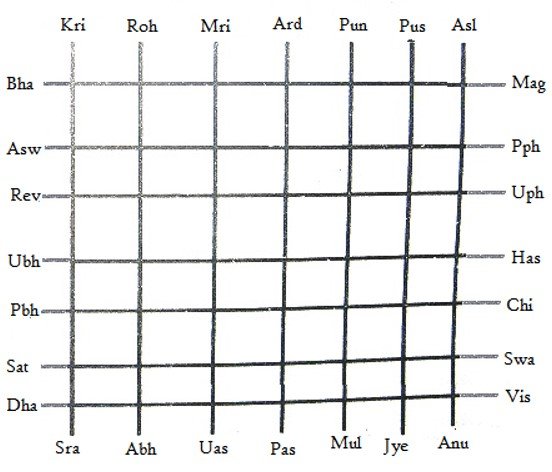
Next Chakra defined is called as ‘SalaaVedhai’ in Tamil which can only be translated as Vedha or affliction. The word may indicate ‘salaakai’ meaning a kind of rod, peg, spike or something like a spear. So according to my understanding the Nakshatra denoted by this Chakra is like that of a spike and is likely to create vedha or affliction. The rule to locate this constellation is –
Draw 7 horizontal lines and 6 vertical lines across them. Then draw two sets of diagonal lines – one set running from the left hand side top to the bottom of the right hand side and the other set from the bottom of the left side to the top of the right hand side.
Find out the Nakshatra in which Moon is placed and if any planet is placed in the Nakshatra opposite to this Moon’s Nakshatra as seen by the diagram it is called as ‘SalaaVedha’ Nakshatra. The figure is shown below.
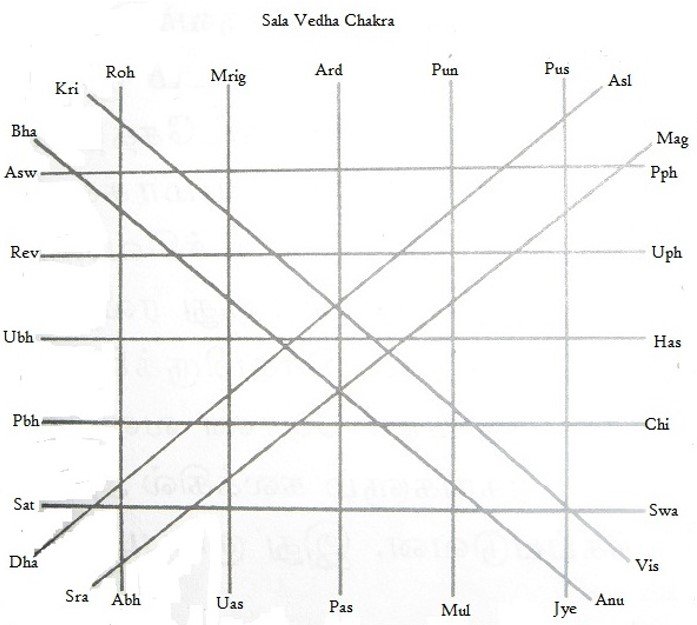
The last type defined in the sloka is classified into two categories-one is Milky Nakshatras and the other is Diamond Nakshatras if it is to be literally translated. Milk here denotes a nature, a quality with full of vitality and energy. As opposed to this is the diamond which is supposed to be of hardness or solidity. Rohini, Krithika, Purvashada, Uttarashada, Sravana, Purvabhadrapada, Uttarabhadrapada, Revathi, Pushya, Aslesha, Maga, Purvaphalguni, Uttaraphalguni and Hastam – All these 14 Nakshatras are termed as Milky nakshatras. The remaining 13 stars viz. Aswini, Bharani, Mrigasirsha, Ardra, Punarvasu, Chitra, Swathi, Visakha, Anuradha, Jyeshta, Mula, Dhanishta and Satabishang are termed as Diamond Nakshatras.
கீழ் அல்லது பூமி நிலை நட்சத்திரம், உச்ச நிலை நட்சத்திரம்,
இடை நிலை நட்சத்திரம், ஜெல சுஷக நட்சத்திரம், கும்ப பூர்த்தி
ஆகுவதின் பாற்கோணொன் பதிமதிக்கோன் மூன்றும்
அல்லதுநேர் கீழ்மேல்மற் றதுவாமம் புலிமால்
வாகனன்கை முதனான்கு மால்கணுக்கீர் மூன்றும்
ஆகயிவை ஈராறு மறலெனன்மற் றதுவாம்
கோககை னாற்றிசைநேர் குறித்தவரைக் கிடையிற்
குறுக்குயர மும்மூன்றாய்க் குறுகமுடிக் கனலீ
தேகமுதற் றிசைநான்கும் இடையிலிருந்து மூன்று
இகழ்தலிது சாற்பூர்த்திப் பெயரிதுவென் பர்களே.
Lower level or Earth level Nakshatra, Higher level Nakshatra,
Middle level Nakshatra, Moving Nakshatra, Fixed nakshatra
Complete pot
In this stanza as indicated by the heading five different classifications are made in respect of the 27 nakshatras with a preparation of a pot completion Chakra.
The nine Nakshatras Bharani, Purvaphalguni, Purvashada, Aswini, Magam, Mulam, Krittika, Uttaraphalguni, Uttarashada are called as Lower level or Earth level Nakshatras.
The three Nakshatras Mrigasirsha, Chitra and Dhanishta are Higher level Nakshatras.
The remaining 15 Nakshatras – Rohini, Hastam, Sravana, Ardra, Swathi, Satabishang, Punarvasu, Visakha, Purvabhadrapada, Pushya, Anuradha, Uttarabhadrapada, Aslesha, Jyeshta and Revati are called as Middle level Nakshatras.
The twelve Nakshatras – Mrigasirsha, Jyeshta, Hasta, Chitra, Swathi, Visakha, Sravana, Dhanishta, Satabishang, Punarvasu, Pushya and Aslesha are termed as Moving Nakshatras.
The remaining 15 Nakshatras – Aswini, Bharani, Krittika, Rohini, Ardra, Maga, Purvaphalguni, Uttaraphalguni, Anuradha, Mula, Uttarashada, Purvabhadrapada, Uttarabhadrapada and Revati are termed as Fixed stars.
Drawing the Pot Completion Chakra: Draw a horizontal as well as a vertical line like a + sign. Draw six slanting lines from left hand top corner to right hand bottom corner. Similarly in the opposite direction viz. from top right hand corner to bottom left hand corner draw six slanting lines. Start naming the tip of these lines beginning from the top central line (the top of the + sign) starting from Krittika and going in clockwise direction and also note to include Abhijit Nakshatra. The Chakra is nothing but an eight direction Chakra. This chakra is used to avoid certain Nakshatras in specified directions. The rule is: Find out the nakshatra in which Sun stands. If any planet is placed in the line of that nakshatra then all the nakshatras in the four directions are to be avoided. If in the diagonal point Nakshatras Sun and the planets are placed then all the 6 Nakshatras in the diagonal lines are to be avoided.
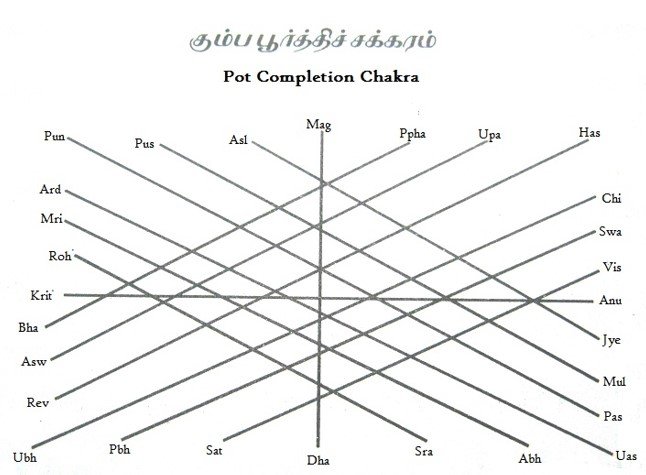
வேதக்கயிறு சுமங்களரச்சு, ஸ்திரீ தீர்க்கப் பொருத்தம்.
பரைகோண்மா றீக்கீறிக் குறுக்கொருநான் காயப்
பாற்கோனுநன் நான்காய்ப்பற் றுவரைக்கி டப்பால்
சிரப்பான்மா வைத்திருவர் தினமுமொரு வரையில்
சேருதலா காதிதுவே தக்கயிறு சேட
அரிக்கோண்டார் நீர்கோண்டிப் படிக்கோண்மாழ் யாழ்க்கோன்
அடிமருங்கு லகடுகள மம்புலிகோள் சிரசாய்ப்
பொருந்தாண்பெண் ணளொருட்கோ ணூறிலவரச் சென்னப்
புகல்பதின்மூன் றிவணான்மேல் புலலிவடீர்க் கமுமே.
Vedha Rope, auspicious Rajju and Stree dirgha agreements
Vedha Agreement is one of the Kuta agreements seen during matching of charts for marriage. Draw a triangle of equal sides and draw four horizontal lines in the middle portion going across the triangle. Then draw two sets of four slanting lines – one running from upper left hand side to lower portion and the other from Lower left hand side going towards the top as shown in the figure below. Start naming the tips of these lines starting from the bottom left side by giving the names of nakshatras beginning from Aswini and going in a clockwise direction.
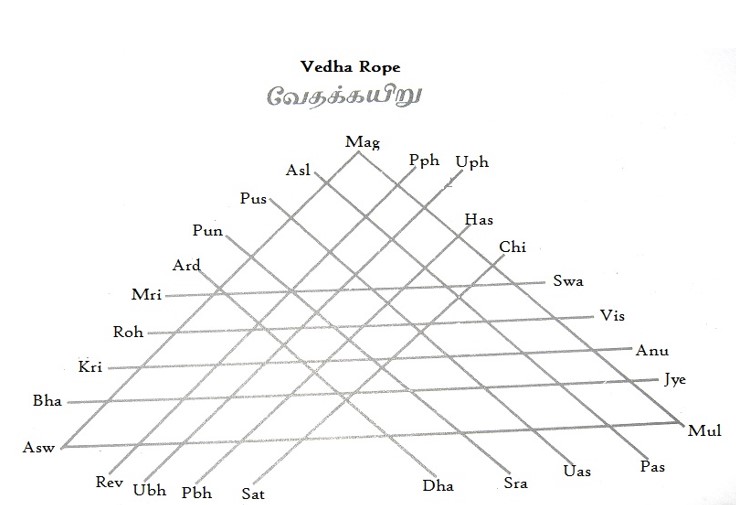
While doing the matching of charts if the Nakshatra of the boy and girl falls in the same line then there is no Vedha agreement. For example if the Nakshatra of the girl is Hasta then there is No Vedha agreement for the girl with a boy having birth star as Uttarabhadrapada.
Notes from Translator: In this case various other classics on Vedha Kuta agreement differ from what is stated above. As per the same for the Hasta nakshatra given in the example above the Vedha nakshatra is Satabishang. For all the nakshatras, I furnish below the Vedha Nakshatra.
Mutual vedha exists between – Aswini-Jyeshta, Bharani-Anuradha, Ardra-Sravana, Visakha-Krittika, Swati-Rohini, Mula-Aslesha, Maga-Revati, Pushya-Purvashada, Punarvasu-Uttarashada, Uttarabhadrapada-Purvaphalguni, Hasta-Satabishang and Uttaraphalguni-Purvabhadrapada.
Mrigasirsha, Chitra, Dhanishta-these three nakshatras are vedha among themselves. Now if we check this list in the figure given above it differs. It is quite possible that I might have drawn the figure and named it wrongly.
Rajju has been classified into 5 categories. They are:
- Aslesha, Jyeshta, Revati, Aswini, Maga and Mula are called as Pada (Foot) Rajju.
- Pushya, Anuradha, Uttarabhadrapada, Bharani, Purvaphalguni and Purvashada are called as Middle (Thigh or Ooru) Rajju.
- Krittika, Uttaraphalguni, Uttarashada, Punarvasu, Visakha and Purvabhadrapada are called as Nabhi (Naval) Rajju.
- Rohini, Hasta, Sravana, Ardra, Swati and Satabishang are called as Kanta(Neck).
- Mrigasirsha, Chitra and Dhanishta are called as Siro (Head) Rajju.
The nakshatras of the boy and the girl should not fall in the same line as shown in the figure below:
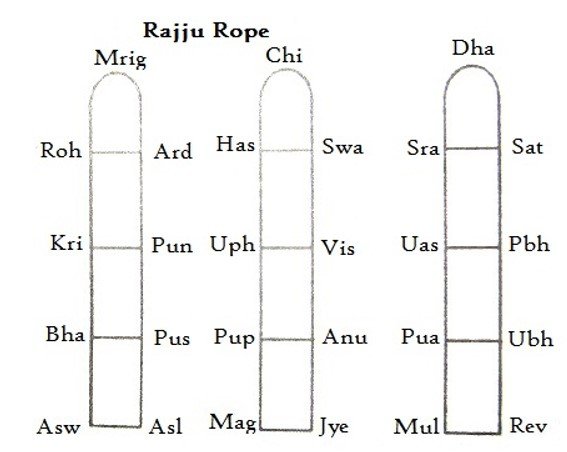
If the boy’s star is beyond 13 from that of the girl, there is said to be Stree Dirgha agreement.
மாகேந்திர நட்சத்திரம், நட்சத்திர மண்டலம், பாவதினம்
மும்மூன்றாய் அனுசனனத் தைந்துதரம் ஏறின்
மொழிவதுமா கேந்திரம்யாழ் மூலமெமன் முரசீர்
அம்மான்கம் மும்மால்வேய் தேர்புலனி யவசித்
தாடியுமா வகிபுள்வெயி லான்சுடரா டையுநேர்
இம்மூன்று மண்டலறீர் மாகேந்திரம் வாயு
வென்பதனன் மற்றதற்கா மிதமிலருக் கிடைசேர்
பம்மாம்ச வூணருறும் தினமாதம் வருடம்
பருபொழுதுதீ றுபயமைமூண் டுப்பவமா குவதே.
Mahendra Nakshatra, Nakshatra Region, Misfortune Nakshatra
If the boy’s nakshatra is beyond 4th or 7th or 10th or 13th or 16th or 19th or 22nd or 25th from that of the girl, then there is Mahendra agreement. [The verse says that starting from the first Kendra which is 4th counting should be done by adding three and that is how the numbers are got above].
Next the verse classifies the nakshatras into four regions which are:
- Mrigasirsha – tbese seven belong to Varuna or Watery region.
- Sravana, Punarvasu, Rohini, Anuradha, Jyeshta, Abhijit, Uttarashada – these seven nakshatras belong to Mahendra Region.
- Aswini, aslesha, Dhanishta, Hasta, Uttaraphalguni, Swati, Chitra – These seven nakshatras are said to be in Vayu (Air) Region.
- Bharani, Krittika, Pushya, Magam, Purvaphalguni, Visakha, Purvabhadrapada – these seven belong to Agni (Fire) Region.
Middle of the Nakshatra where malefic is placed, Nakshatras in which malefics are placed, Monthly two nakshatras and yearly 15 nakshatras are termed as Misfortune nakshatras.
Notes from Translator: Could not understand the last two line of the verse. I have made a liter translation but I feel there must be some inner meaning to name the nakshatras as misfortune one. Those who are well versed in Tamil may kindly clarify the same.
நட்சத்திர வடிவு, நட்சத்திரத் தொகை, நட்சத்திரத் திசைச் சூலம்
மாச்சிரசவ் வடுப்புகள் றையூற்றாறேங் காய்க்கண்
மண்மணியா வணம்புடற்பூ வம்மிநுகங் கைமான்
கோச்சுடரம் முறமுடப்புல் வீட்டிபொற்கா ளங்கோல்
குவித்ததவிட் டுக்கூட்டங் கொத்தோட்த் துருவர
முச்சிவைமுக் குளநாற்கான் மற்றதுநேர் வேய்மா
முறந்தீயா றன்மதிமான் மூன்றீரா றத்தேர்
தேச்சுடரா டைக்கேகம் வீப்பன்மறை மற்றாம்
திசைச்சூழ்புட் கோன்மாறேர் தையென்றுத் திரமே.
Nakshatra shapes or forms, Nakshatra numbers, Nakshatra Soola direction
In this verse the author has given description of the shape, the total number in the group. I have tabulated them for easy reading and understanding. Some of the translations may be misleading and hence I have given the Tamil words in bracket when in doubt.
Nakshatra | No. of stars | Shape |
Aswini | Six | Head of a horse |
Bharani | Three | Fire-place (அடுப்பு) |
Krittika | Six | Rays of sun |
Rohini | Twelve | Orifice of a spring |
Mrigasirsha | Three | 3 eyes of coconut |
Ardra | One | Kind of Paddy(இராசமணி) |
Punarvasu | Six | Bazaar street |
Pushya | Four | Flower of Snake-gourd |
Aslesha | Four | Horizontal Stone for grinding spices |
Maga | Four | Shaft of a plough |
Purvaphalguni | Four | Legs of a couch |
Uttaraphalguni | Four | Legs of a couch |
Hasta | Four | Palm of the hand(கைத்தலம்) |
Chitra | One | Eye of tiger |
Swati | One | Lamp (தீபம்) |
Visakha | Six | A kind of winnowing fan for separating chaff from grain, bran from flour |
Anuradha | Four | Crooked Palmyra (முடப்பனை) |
Jyeshta | Four | Earthern Vessel |
Mula | Four | Trident or Trumpet (கொற்காளம்) |
Purvashada | Four | Legs of a couch |
Uttarashada | Four | Legs of a couch |
Sravana | Three | Measuring rod (முழக்கோல்) |
Dhanishta | Many | Heap of bran (தவிட்டுக்கூட்டம்) |
Satabishang | Four | Bunch of Flowers |
Purvabhadrapada | Four | Legs of a couch |
Utttarabhadrapada | Four | Legs of a couch |
Revati | Four | Boat |
The last classification in this verse is the Sula direction. Only for 8 stars it has been given and they are:
Dhanishta and Jyeshta – East
Aswini and Sravana – South
Rohini and Pushya – West
Hasta and Uttaraphalguni – North
சன்மாதி நட்சத்திரத்தின் பெயரும், அதிபரும், குலமும்
என்றருகன் பணிகுருக்கே திந்தசிதன் சிதன்சேய்க்
கிகத்துதய முதல்சன்ப சம்பவிபச் சேமம்
பின்றருப்ரத் யாரமச்சா தகம்வகைமித் திரமிப்
பேர்ப்பரமம் இவைநோக்காம் குலப்பேர்பே சிடிற்றீ
ஒற்றுமைத்ர யமுந்தேர்புல் லோடநுக மும்முன்
னும்பரவ சித்தின்னுந் தாரொகுத்ரங் களுஞ்சே
மன்றினக்கோள் குருகுமதிக் கோன்மனுமற் றதுநால்
வரசுரர்வே டர்கீழ்மேல் வாரமதிப் பதுவே.
Names given to Janma Nakshatras, Its Lords and its lineage
Nakshatra Name Lord
1st Janma(Birth) Sun
2nd Sampat (Wealth) Mercury
3rd Vipat (Agony) Rahu
4th Kshema (Welfare) Jupiter
5th Pratyak (Obstacles) Ketu
6th Sadhana (Achievement) Moon
7th Vadha (Death) Saturn
8th Mayithram (Friend) Venus
9th Pramamayithram (Great Friend) Mars
Similarly take the Nakshatras for Anujanma as well Trijanma Nakshatras.
- Krittika, Purvaphalguni, Purvashada, Purvabhadrapada- these four nakshatras are of Brahmin lineage.
- Rohini, Anuradha, Revati, Maga- these four belong to Kshatriya lineage.
- Aswini, Punarvasu, Abhijit, Hasta – these four belong to Vaisya lineage.
- Pushya, Uttaraphalguni, Uttarashada, Uttarattadi – these four are terms as Sudra lineage.
- Ardra, Swati, Satabishang, Mula – these four belong to Rakshasa lineage.
- Mrigasirsha, Chitra, Dhanishta, Jyeshta – these four are said to belong to hunters lineage.
- Bharani, Aslesha, Sravana, Viskha – these are of Low lineage.
Henceforth we will start telling about the week day section.
Publisher has already provided introduction about this great Tamil Classic “Kumaraswamiyam” in the earlier translations. Hence it will not be apt to give further introduction. Hence this post script. Here I wish to share with you some more points which may be of interest to the readers as it throws light on the availability of the original scripts as well as about the author of this script.
In Thanjavur Saraswati Mahal Library (in Tamil Nadu) there are three bundles of palm leaves numbered as 802 e, 1007 a, 15726. These three bundles contain all the verses of this classic. In 802 e, the sections are in a haphazard manner. But the meanings and the notes given there are very much informative. In bundle 1007 a, all the verses are in full and arranged properly. Taking into consideration these two bundles, the entire verses were published after careful scrutiny and study by Mrs. Sathyabhama Kameswaran with the due permission of the authorities concerned. The third bundle viz. 15726 was a smaller one and this was utilized for comparison. Incidentally, there two more bundle of leaves in the Library with the same name viz. Kumaraswamiyam – One is about architecture and the other is the Sanskrit Kavya (poems) written by the Great Kalidasa.
The author of this classic is Kumaraswamy. He belong to a place called Veeravanallur in Tamilnadu and his father was Mariyaadum Perumal. He was worshipping Lord Muruga or Karthikeya. Because of the grace of Lord Muruga, he learnt Jyothish. It was stated by him that by the order of Lord Muruga, he wrote the treatise Kumaraswamiyam and presented it first in the presence of Lord Karthikeya in Tiruchendur. A proof for this exists in the special preface.
சொல்லுறும் பொழில்கள் சூழுஞ்செந்திலம் பதியைச் சேர்ந்து
வெல்லருங் கதிர்கொள் வேலன் விளங்குசன் ன தியி லந்தச்
சொல்லரும் புகழ்க்கு மார சுவாமிய மென்னு நூலை
யெல்லறும் கனகப் பூணான் இனிதரங் கேற்றி னானே.
Kumaraswamiyam is written after the author has studied various of the classics and it is mentioned in the preface itself that nearly 48 old classics were referred and then this was written. The book is divided into 4 major chapters – Principal chapter, Jyothish Chapter, Muhurta Chapter and finally a chapter on thoughts (called as Chintana). Each chapter is again subdivided into various sections. Principal chapter has 14 sections, Jyotish Chapter – the biggest one has 23 sections, Muhurta has 6 sections followed by 11 sections in Chintana chapter.
Almost all matters relating to Jyotish has been covered in this treatise. Only problem as stated at the beginning is the poetical language used for which it is difficult to get the correct meanings in Tamil itself leave alone translating them into English.
Learn Astrology: Join Our Upcoming Astrology Classes — Click Here
Learn Astrology: Join Our Recorded Astrology Classes — Click Here
 Saptarishis Astrology Magazine Into Creating Astrologers
Saptarishis Astrology Magazine Into Creating Astrologers
